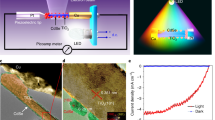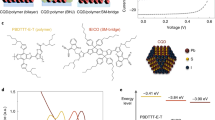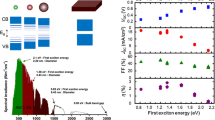Abstract
Colloidal quantum dot (CQD) solar cells have drawn a lot of attention because of their potential for bandgap engineering, which enables broad and powerful absorption in the wavelength of sunlight, and low-cost process based on the solution phase production. However, the interfacial problems resulting from the heterojunction structure containing electron and hole transport layers cause a hysteresis phenomenon that weakens the device stability. We used the dry-transfer technique to implement a hole transport layer (HTL) with enhanced interfacial properties in devices. This approach is highly reproducible and allows for precise thickness control of the HTL. It also uses substantially less environmentally harmful organic solvents for the ligand exchange process than those required by the previous layer-by-layer (LbL) deposition technique. Additionally, about 400 nm thick CQD film could be deposited without the ligand exchange process, and a power conversion efficiency of 10% with minimized hysteresis was achieved using this method. Moreover, by improving the interfacial properties over the traditional LbL approach, it was feasible to lower the charge transfer resistance related to the device's hysteresis by a factor of up to four or more.




Similar content being viewed by others
Data Availability
All data are available from the corresponding authors on reasonable request.
References
Donegá, C. D. M. (2011). Synthesis and properties of colloidal heteronanocrystals. Chemical Society Reviews, 40, 1512–1546.
Gao, J., Jeong, S., Lin, F., Erslev, P. T., Semonin, O. E., Luther, J. M., & Beard, M. C. (2013). Improvement in carrier transport properties by mild thermal annealing of PbS quantum dot solar cells. Applied Physics Letters, 102, 043506.
Chuang, C.-H.M., Brown, P. R., Bulović, V., & Bawendi, M. G. (2014). Improved performance and stability in quantum dot solar cells through band alignment engineering. Nature Materials, 13, 796–801.
Kramer, I. J., & Sargent, E. H. (2014). The architecture of colloidal quantum dot solar cells: Materials to devices. Chemical Reviews, 114, 863–882.
Jang, J., Shim, H. C., Ju, Y., An, H., Yu, J.-S., Kwak, S.-W., Lee, T.-M., Kim, I., & Jeong, S. (2015). All-solution-processed PbS quantum dot solar modules. Nanoscale, 7, 8829–8834.
Kirmani, A. R., Sheikh, A. D., Niazi, M. R., Haque, M. A., Liu, M., De Arquer, F. P. G., Xu, J., Sun, B., Voznyy, O., Gasparini, N., Baran, D., Wu, T., & Sargent, E. H. (2018). Overcoming the ambient manufacturability-scalability-performance bottleneck in colloidal quantum dot photovoltaics. Advanced Materials, 30, 1801661.
Krebs, F. C., Gevorgyan, S. A., & Alstrup, J. (2009). A roll-to-roll process to flexible polymer solar cells. Journal of Materials Chemistry, 19, 5442–5451.
Kramer, I. J., Moreno-Bautista, G., Minor, J. C., Kopilovic, D., & Sargent, E. H. (2014). Colloidal quantum dot solar cells on curved and flexible substrates. Applied Physics Letters, 105, 163902.
Zhang, X., Öberg, V. A., Du, J., Liu, J., & Johansson, E. M. J. (2018). Extremely lightweight and ultra-flexible infrared light-converting quantum dot solar cells with high power-per-weight output using a solution-processed bending durable silver nanowire-based electrode. Energy & Environmental Science, 11, 354–364.
Zhang, X., Aitola, K., Hägglund, C., Kaskela, A., Johansson, M. B., Sveinbjörnsson, K., Kauppinen, E. I., & Johansson, E. M. J. (2017). Dry-deposited transparent carbon nanotube film as front electrode in colloidal quantum dot solar cells. Chemsuschem, 10, 434–441.
Zhang, Y., Gu, M., Li, N., Xu, Y., Ling, X., Wang, Y., Zhou, S., Li, F., Yang, F., Ji, K., Yuan, J., & Ma, W. (2018). Realizing solution-processed monolithic PbS QDs/perovskite tandem solar cells with high UV stability. Journal of Materials Chemistry A, 6, 24693–24701.
Liu, M., Voznyy, O., Sabatini, R., de Arquer, F. P. G., Munir, R., Balawi, A. H., Lan, X., Fan, F., Walters, G., Kirmani, A. R., Hoogland, S., Laquai, F., Amassian, A., & Sargent, E. H. (2017). Hybrid organic–inorganic inks flatten the energy landscape in colloidal quantum dot solids. Nature Materials, 16, 258–263.
Xu, J., Voznyy, O., Liu, M., Kirmani, A. R., Walters, G., Munir, R., Abdelsamie, M., Proppe, A. H., Sarkar, A., de Arquer, F. P. G., Wei, M., Sun, B., Liu, M., Ouellette, O., Quintero-Bermudez, R., Li, J., Fan, J., Quan, L., Todorovic, P., … Sargent, E. H. (2018). 2D matrix engineering for homogeneous quantum dot coupling in photovoltaic solids. Nature Nanotechnology, 13, 456–462.
Kim, J., Ouellette, O., Voznyy, O., Wei, M., Choi, J., Choi, M.-J., Jo, J. W., Baek, S.-W., Fan, J., Saidaminov, M. I., Sun, B., Li, P., Nam, D.-H., Hoogland, S., Lu, Z.-H., de Arquer, F. P. G., & Sargent, E. H. (2018). Butylamine-catalyzed synthesis of nanocrystal inks enables efficient infrared CQD solar cells. Advanced Materials, 30, 1803830.
Choi, M.-J., de Arquer, F. P. G., Proppe, A. H., Seifitokaldani, A., Choi, J., Kim, J., Baek, S.-W., Liu, M., Sun, B., Biondi, M., Scheffel, B., Walters, G., Nam, D.-H., Jo, J. W., Ouellette, O., Voznyy, O., Hoogland, S., Kelley, S. O., Jung, Y. S., & Sargent, E. H. (2020). Cascade surface modification of colloidal quantum dot inks enables efficient bulk homojunction photovoltaics. Nature Communications, 11, 103.
Choi, J. J., Lim, Y.-F., Santiago-Berrios, M. B., Oh, M., Hyun, B.-R., Sun, L., Bartnik, A. C., Goedhart, A., Malliaras, G. G., Abruña, H. D., Wise, F. W., & Hanrath, T. (2009). PbSe nanocrystal excitonic solar cells. Nano Letters, 9, 3749–3755.
Pattantyus-Abraham, A. G., Kramer, I. J., Barkhouse, A. R., Wang, X., Konstantatos, G., Debnath, R., Levina, L., Raabe, I., Nazeeruddin, M. K., Gratzel, M., & Sargent, E. H. (2010). Depleted-heterojunction colloidal quantum dot solar cells. ACS Nano, 4, 3374–3380.
Gao, J., Perkins, C. L., Luther, J. M., Hanna, M. C., Chen, H.-Y., Semonin, O. E., Nozik, A. J., Ellingson, R. J., & Beard, M. C. (2011). n-Type transition metal oxide as a hole extraction layer in PbS quantum dot solar cells. Nano Letters, 11, 3263–3266.
Gao, J., Luther, J. M., Semonin, O. E., Ellingson, R. J., Nozik, A. J., & Beard, M. C. (2011). Quantum dot size dependent J−V characteristics in heterojunction ZnO/PbS quantum dot solar cells. Nano Letters, 11, 1002–1008.
Yao, K., Li, F., He, Q., Wang, X., Jiang, Y., Huang, H., & Jen, A. K. Y. (2017). A copper-doped nickel oxide bilayer for enhancing efficiency and stability of hysteresis-free inverted mesoporous perovskite solar cells. Nano Energy, 40, 155–162.
Lin, L., Jones, T. W., Wang, J.T.-W., Cook, A., Pham, N. D., Duffy, N. W., Mihaylov, B., Grigore, M., Anderson, K. F., Duck, B. C., Wang, H., Pu, J., Li, J., Chi, B., & Wilson, G. J. (2020). Strategically constructed bilayer tin (IV) oxide as electron transport layer boosts performance and reduces hysteresis in perovskite solar cells. Small (Weinheim an der Bergstrasse, Germany), 16, 1901466.
Song, J. H., Mai, X. D., Jeong, S., & Kim, Y.-H. (2017). Hysteresis and photoinstability caused by mobile ions in colloidal quantum dot photovoltaics. Journal of Physical Chemistry Letters, 8, 5259–5263.
Lau, C. F. J., Deng, X., Zheng, J., Kim, J., Zhang, Z., Zhang, M., Bing, J., Wilkinson, B., Hu, L., Patterson, R., Huanga, S., & Ho-Baillie, A. (2018). Enhanced performance via partial lead replacement with calcium for a CsPbI3 perovskite solar cell exceeding 13% power conversion efficiency. Journal of Materials Chemistry A, 6, 5580–5586.
Son, D.-Y., Kim, S.-G., Seo, J.-Y., Lee, S.-H., Shin, H., Lee, D., & Park, N.-G. (2018). Universal approach toward hysteresis-free perovskite solar cell via defect engineering. Journal of the American Chemical Society, 140, 1358–1364.
Hu, Z., Miao, J., Li, T., Liu, M., Murtaza, I., & Meng, H. (2018). Reduced interface losses in inverted perovskite solar cells by using a simple dual-functional phenanthroline derivative. Nano Energy, 43, 72–80.
Kovalenko, M. V., Scheele, M., & Talapin, D. V. (2009). Colloidal nanocrystals with molecular metal chalcogenide surface ligands. Science, 324, 1417–1420.
Yang, Z., Janmohamed, A., Lan, X., de Arquer, F. P. G., Voznyy, O., Yassitepe, E., Kim, G.-H., Ning, Z., Gong, X., Comin, R., & Sargent, E. H. (2015). Colloidal quantum dot photovoltaics enhanced by perovskite shelling. Nano Letters, 15, 7539–7543.
Lin, Q., Yun, H. J., Liu, W., Song, H.-J., Makarov, N. S., Isaienko, O., Nakotte, T., Chen, G., Luo, H., Klimov, V. I., & Pietryga, J. M. (2017). Phase-transfer ligand exchange of lead chalcogenide quantum dots for direct deposition of thick, highly conductive films. Journal of the American Chemical Society, 139, 6644–6653.
Mailoa, J. P., Bailie, C. D., Johlin, E. C., Hoke, E. T., Akey, A. J., Nguyen, W. H., McGehee, M. D., & Buonassisi, T. (2015). A 2-terminal perovskite/silicon multijunction solar cell enabled by a silicon tunnel junction. Applied Physics Letters, 106, 121105.
Bailie, C. D., Christoforo, M. G., Mailoa, J. P., Bowring, A. R., Unger, E. L., Nguyen, W. H., Burschka, J., Pellet, N., Lee, J. Z., Grätzel, M., Noufi, R., Buonassisi, T., Salleo, A., & McGehee, M. D. (2015). Semi-transparent perovskite solar cells for tandems with silicon and CIGS. Energy & Environmental Science, 8, 956–963.
Liu, P., Bai, L., Yang, J., Gu, H., Zhong, Q., Xie, Z., & Gu, Z. (2019). Self-assembled colloidal arrays for structural color. Nanoscale Advances, 1, 1672–1685.
Sukharevska, N., Bederak, D., Goossens, V. M., Momand, J., Duim, H., Dirin, D. N., Kovalenko, M. V., Kooi, B. J., & Loi, M. A. (2021). Scalable PbS quantum dot solar cell production by blade coating from stable inks. ACS Applied Materials & Interfaces, 13, 5195–5207.
Kim, G.-W., Shindea, D. V., & Park, T. (2015). Thickness of the hole transport layer in perovskite solar cells: Performance versus reproducibility. RSC Advances, 5, 99356–99360.
Crisp, R. W., Kroupa, D. M., Marshall, A. R., Miller, E. M., Zhang, J., Beard, M. C., & Luther, J. M. (2015). Metal halide solid-state surface treatment for high efficiency PbS and PbSe QD solar cells. Science and Reports, 5, 9945.
Jeong, K. S., Tang, J., Liu, H., Kim, J., Schaefer, A. W., Kemp, K., Levina, L., Wang, X., Hoogland, S., Debnath, R., Brzozowski, L., Sargent, E. H., & Asbury, J. B. (2012). Enhanced mobility-lifetime products in PbS colloidal quantum dot photovoltaics. ACS Nano, 6, 89–99.
Lu, K., Wang, Y., Liu, Z., Han, L., Shi, G., Fang, H., Chen, J., Ye, X., Chen, S., Yang, F., Shulga, A. G., Wu, T., Gu, M., Zhou, S., Fan, J., Loi, M. A., & Ma, W. (2018). High-efficiency PbS quantum-dot solar cells with greatly simplified fabrication processing via “solvent-curing.” Advanced Materials, 30, 1707572.
Kim, B.-S., Hong, J., Hou, B., Cho, Y., Sohn, J. I., Cha, S., & Kim, J. M. (2016). Inorganic-ligand exchanging time effect in PbS quantum dot solar cell. Applied Physics Letters, 109, 063901.
Tang, J. A., & Sargent, E. H. (2011). Infrared colloidal quantum dots for photovoltaics: fundamentals and recent progress. Advanced Materials, 23, 12–29.
Luther, J. M., Law, M., Song, Q., Perkins, C. L., Beard, M. C., & Nozik, A. J. (2008). Structural, optical, and electrical properties of self-assembled films of PbSe nanocrystals treated with 1,2-ethanedithiol. ACS Nano, 2, 271–280.
Park, M., Hong, S. C., Jang, Y., Byeon, J., Jang, J., Han, M., Kim, U., Jeong, K., Choi, M., & Lee, G. (2023). Scalable production of high performance flexible perovskite solar cells via film-growth-megasonic-spray-coating system. International Journal of Precision Engineering and Manufacturing-Green Technology, 10, 1223–1234.
Singh, R., & Parashar, M. (2020). Origin of hysteresis in perovskite solar cells. In J. Ren & Z. Kan (Eds.), Soft-matter thin film solar cells (pp. 1–42). AIP Publishing LLC.
Acknowledgements
This work was financially supported the Korea Institute of Machinery and Materials (KIMM) NK242C and NK243H project and by the international collaborative R&D program (No. 0000895) funded by the Korea Institute for Advancement of Technology (KIAT).
Author information
Authors and Affiliations
Contributions
This work was financially supported the Korea.
Corresponding authors
Ethics declarations
Conflict of Interest
The authors declare that they have no known competing financial interests or personal relationships that could have appeared to influence the work reported in this paper.
Additional information
Publisher's Note
Springer Nature remains neutral with regard to jurisdictional claims in published maps and institutional affiliations.
Supplementary Information
Below is the link to the electronic supplementary material.
Rights and permissions
Springer Nature or its licensor (e.g. a society or other partner) holds exclusive rights to this article under a publishing agreement with the author(s) or other rightsholder(s); author self-archiving of the accepted manuscript version of this article is solely governed by the terms of such publishing agreement and applicable law.
About this article
Cite this article
Shim, H.C., Song, J.H., Kim, A. et al. Dry Transfer Printed Hole Transport Layer for Hysteresis-Free Colloidal Quantum Dot Solar Cells. Int. J. of Precis. Eng. and Manuf.-Green Tech. (2024). https://doi.org/10.1007/s40684-023-00594-5
Received:
Revised:
Accepted:
Published:
DOI: https://doi.org/10.1007/s40684-023-00594-5




